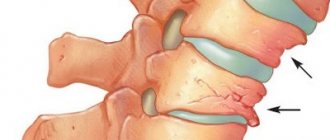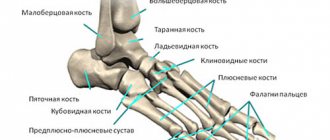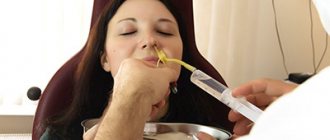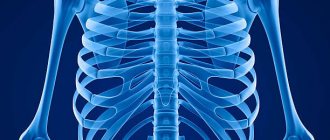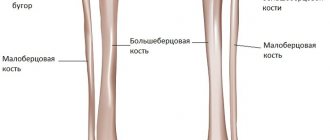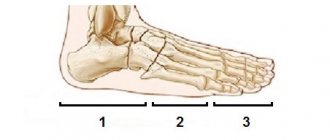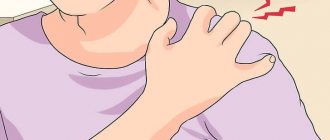What to do?
- Emergency care for superficial injuries (superficial scratches, minor bruises) can be provided at home: the injuries should be washed with soap and water, and ice should be applied to the bruised area. If blood is flowing from the wound, a tampon with hydrogen peroxide should be pressed onto the area for 3–5 minutes.
- Bleeding from the nose - in the absence of signs of fracture of the nasal bones and nasal septum - you can try to stop it yourself (by packing the nasal passage with a tight gauze or cotton swab moistened with hydrogen peroxide or cold water). If the bleeding is severe and, despite all efforts, does not stop, you must call an ambulance.
- If you suspect a fracture of the nasal bones or nasal septum, you should contact a specialized clinic as soon as possible.
Typically a nasal fracture occurs:
- when falling;
- if a person crashes into a tree, glass wall, etc. while walking;
- in a fight, when playing contact sports (basketball, wrestling...);
- in case of car accidents, especially if you do not wear a seat belt;
- when bench pressing, if you do not use a safety net.
Therefore, you should take precautions:
- Always buckle up and secure children in the car;
- wear protective equipment when playing hockey and other contact sports;
- Wear a helmet when riding a bicycle or motorcycle.
Dangerous symptoms
If you suspect a fracture of the nasal bones or nasal septum, it is important to pay attention to the following signs of combined trauma and complications:
- heavy bleeding. Possible in case of damage to the nasal mucosa with bone fractures;
- lacrimation. May occur with combined trauma to the orbit and lacrimal ducts;
- release of cerebrospinal fluid. It is observed with a fracture of the ethmoid bone, which is adjacent to the upper nasal passages.
It is difficult for a layperson to distinguish between lacrimation and a cerebrospinal fluid leak, so clear or blood-stained fluid coming from the nose should raise suspicion. In such cases, you should seek qualified help as soon as possible.
Symptoms
Clinical signs of a nasal fracture:
- A nasal fracture causes severe pain. The patient is in shock or even fainting.
- Slight bleeding from the nasal slits occurs, which is blocked quickly and independently. In quite rare cases, blood flows in a stream and requires nasal packing. Such bleeding can lead to significant blood loss.
- The skin and mucous membranes are damaged, which can be manifested by the accumulation of air in the superficial fat layer. During the examination, the doctor determines whether the wound communicates with the nasal cavity.
- Then swelling of the soft tissues of the nose, eyes and cheekbones develops, bruising appears in the area of the cheekbones and eyelids. Hemorrhage under the skin occurs as a result of damage to blood vessels. After a day, swelling of the nose and surrounding tissues becomes extensive. Bruises form around the nose and under the eyes. Noticeable swelling in the impact area allows you to know whether the nose is broken. This symptom, combined with pain, deformity and bleeding, gives the characteristic clinical picture of a nasal fracture.
- Difficulty in nasal breathing is caused by displacement of bone fragments, deformation of the nasal septum, and increasing swelling.
- In case of a fracture of the bone and cartilaginous structures of the nose, the crunching of the fragments is determined by palpation - a clear sign that allows the traumatologist to make the correct diagnosis and prescribe adequate treatment.
- If the nose is broken, mucus continuously leaks from it.
- In the future, infection may occur and fever, pain and redness may appear at the site of the lesion. Softening of the tissue indicates the beginning of the process of abscess formation.
Nasal septum fracture
Nose trauma is always accompanied by swelling, which does not allow doctors to perform surgery on the same day, so treatment always begins with conservative therapy. In addition, a nasal injury can be combined with a concussion, in which surgery is undesirable, so a pause of several days is a necessary condition.
The bone of the bridge of the nose may simply sink from the blow, without a fracture. It may break, but not completely, but like a willow branch breaks: the break is only on one side, on the other - everything is intact. These types of fractures are most often observed in children, because their bone tissue contains more elastic fibers than adults. In any case, the bone must be put back in place to restore nasal breathing and the external shape of the nose.
In our country, such operations are performed in two ways.
- An old method that is still used in some hospitals. Under local anesthesia with a special instrument, similar to a long narrow spatula, the bone is lifted and fixed from below with a tight gauze swab. After a day or two they take it out, and the bone... sometimes it falls off again.
- A new method that uses anesthesia (general anesthesia). Foreign doctors have proven that fixing tampons are actually not needed. The main thing is to place the bone correctly, because there are no muscles around it that could move it. And it is more convenient to place it correctly if the operation is performed under general anesthesia: the patient does not feel anything, does not experience fear, does not interfere with the surgeon’s work... In this case, a small tampon made of perforated rubber is used, with gauze inside, which serves only to absorb moisture. It does not injure the mucous membrane as much as a tight gauze swab does, and healing proceeds faster. Within a month, a bone callus forms at the site of retraction, which firmly strengthens the bridge of the nose. Such operations are performed abroad and in many domestic clinics.
Complications after a fracture
After a fracture of the nasal bones, the consequences of the damage can be completely different. Serious complications include problems such as hematoma or abscess of the septum, subperiosteal abscess. Also quite likely consequences of such an injury are chronic diseases, including traumatic curvature of the nasal septum, chronic rhinitis, which causes a persistent impairment of the ability to breathe through the nose. It doesn’t even make sense to talk in detail about the unpleasant cosmetic effect that occurs due to such an injury if the nose is broken.
Interesting First aid for brain injuries
Deviated nasal septum
In case of injury, a deviated nasal septum occurs less frequently than a fracture or retraction of a bone. But the operation to restore it is more difficult. In most of our hospitals it is performed the old fashioned way, according to the Killian method, developed back in 1901. In front of the place where the curvature is located, the doctor uses a scalpel to cut the mucous membrane, peel it off and cut out the deformed area. Then he presses the mucous membrane tightly with a gauze swab. The tampon lasts up to 5 days.
The problem is that the cartilage of the nasal septum is covered on both sides by the perichondrium, from which it grows, and the mucous membrane is already located on it. In the place where the fragment of the perichondrium is removed along with a piece of cartilage, under the influence of a constant flow of air, the mucous membrane begins to dry out. A hole may form in it, which enlarges over time, while the cartilage becomes exposed and may begin to deteriorate. In such cases, repeated surgery is required to close the resulting hole.
Now there are techniques that allow you to align the septum in a less traumatic way. For example, surgery using a microscope and endoscopic techniques. The doctor inserts a thin fiber-optic tube into the nasal cavity, which has a built-in light guide and a video camera that transmits the image to the monitor screen. Moreover, they reach the place of curvature of the cartilage without damaging the mucous membrane. An incision is made in the skin at the entrance to the nostril. The tissues are moved apart, the deformed section of cartilage is removed, taken out, straightened using a special apparatus, and inserted back. The nasal septum is compressed on both sides with silicone plates and stitched for fixation. A small cosmetic stitch is made at the entrance to the nostril. After a week, the silicone plates can be removed. The septum turns out smooth, the mucous membrane does not suffer or become inflamed, the nose breathes freely.
How to distinguish a fracture from a bruise?
What do you need to know about this? Many people are interested in how to identify a broken nose or bruise. In this case, the signs are quite similar to each other. However, there are some distinctive features. For example, if the nose is only injured and there is no fracture, then swelling will appear only along the edge of the damaged organ. Painful sensations from bruises are quite tolerable. If the bone is damaged, the pain becomes unbearable, and the patient may even go into shock. Bleeding from a bruise is not so severe and can be easily stopped using special compresses and vasoconstrictor drops. The symptoms of a broken nose and a bruised nose are similar. However, in case of bone damage, the clinical picture will be more pronounced.
- Nose fracture: symptoms, how to find out if the nose is broken, treatment, consequences
Where to treat nasal injuries?
It is best to treat a nasal injury in a clinic that specializes in oral and maxillofacial surgery. The diagnosis of a fracture of the nasal bones and nasal septum is usually made on the basis of x-rays.
Such injuries are dangerous not only because of a cosmetic defect. A change in the diameter of the nasal passages due to injury often leads to the subsequent development of persistent vasomotor rhinitis. When one of the nasal passages narrows, the child’s brain, through the neuro-reflex endings located in the mucous membrane, receives a signal about trouble (as with inflammation). In this regard, a reflex secretion of mucous fluid begins, similar to a runny nose. Such a “runny nose” can bother a person throughout his life. Sometimes in such cases, the patient is mistakenly diagnosed with “allergic rhinitis” and appropriate therapy is carried out for a long time, persistently and unsuccessfully. Meanwhile, if correction is carried out in time after an injury, nothing like this will happen.
If surgery is necessary, parents have 7-10 days after the injury (while the swelling subsides) to choose a hospital.
Clinic selection criteria:
- Find out which hospitals perform nasal septum surgeries under general anesthesia. The requirement is understandable: in such ENT departments there are specially trained anesthesiologists, doctors are proficient in modern techniques, the operation can be performed efficiently and comfortably for the child, and recovery will come faster.
- Ask how often such operations are performed in this hospital, including for children.
- If you are going to have surgery on the nasal septum, it is good if it is done under a microscope or using endoscopy.
Causes
Various types of injuries can lead to a fracture:
- of a domestic nature (a fall, for example, while intoxicated or as a consequence of an epileptic seizure);
- criminal in nature (causing bodily harm, causing intentional harm to health);
- of a sporting nature (obtained through boxing and martial arts);
- production (often the result of safety violations).
Recently, injuries sustained in a car accident have also become more frequent. Military injuries are possible.
Sources
- Yan S., Zeng N., Chen G., Chen Y., Wu Z., Pan H., Teng Y., Ma X., Li L. Presentation and management of nasal foreign bodies in a Chinese metro area. // Medicine (Baltimore) - 2021 - Vol100 - N16 - p.e25626; PMID:33879736
- Basa K., Ezzat W.H. Soft Tissue Trauma to the Nose: Management and Special Considerations. // Facial Plast Surg - 2021 - Vol - NNULL - p.; PMID:33853135
- Hamrang-Yousefi S., Kingsley-Smith H., Munroe-Gray T., Anyanechi M., Rollin M. Patterns of referral for fractured nose during major sporting events: a 10-year follow up. // Ann R Coll Surg Engl - 2021 - Vol103 - N4 - p.282-284; PMID:33682468
- Saleem SN., Hawass Z. Computed Tomography Study of the Mummy of King Seqenenre Taa II: New Insights Into His Violent Death. // Front Med (Lausanne) - 2021 - Vol8 - NNULL - p.637527; PMID:33681262
- Mo YW., Cho GY., Mo YT., Lee DL. National level data analysis of facial lacerations in Korea using the National Health Insurance Service (NHIS) database. // Medicine (Baltimore) - 2021 - Vol100 - N9 - p.e24163; PMID:33655909
- Hope N., Young K., Mclaughlin K., Smyth C. Nasal Trauma: Who Nose what happens to the non-manipulated? // Ulster Med J - 2021 - Vol90 - N1 - p.10-12; PMID:33642627
- Heichel J., Struck HG., Viestenz A. . // Laryngorhinootologie - 2021 - Vol100 - N3 - p.211-216; PMID:33636731
- Jiang Q., Liu Y., Song S., Wei W., Bai Y. Association between N95 respirator wearing and device-related pressure injury in the fight against COVID-19: a multicentre cross-sectional survey in China. // BMJ Open - 2021 - Vol11 - N2 - p.e041880; PMID:33602704
- Marofi F., Azizi R., Motavalli R., Vahedi G., Nasimi M., Yousefi M., Motavalli Y., Tahmasebi S., Gharibi T., Mohammed RN., Etemadi J., Khiavi FM. COVID-19: Our Current Knowledge of Epidemiology, Pathology, Therapeutic Approaches, and Diagnostic Methods. // Anticancer Agents Med Chem - 2021 - Vol - NNULL - p.; PMID:33563186
- Ou M., Fan W., Sun F., Li M., Lin M., Yu Y., Liang S., Liao H., Jie W., Cai Y., Chen F., Chen X., Zhao T ., Tang P., Cui L., Zhou H. Nasal Delivery of AntagomiR-741 Protects Against the Radiation-Induced Brain Injury in Mice. // Radiat Res - 2021 - Vol195 - N4 - p.355-365; PMID:33544844
Conclusion
The only correct decision for a person who has received a serious injury to his own nose, if it is broken, is that he will not make the slightest attempt to set this organ on his own. Such manipulations, which individuals rashly try to perform, are extremely dangerous, since they can additionally damage soft tissues with bone fragments, which will only significantly increase the already heavy bleeding. All such events should be left to medical personnel, who will do them as carefully and carefully as possible.
Anatomy of the external nose
The external nose has a complex anatomy, being an organ with a cartilaginous and bony skeleton, covered with thick skin. It consists of the following sections: the root (the area between the brow ridges), tapering downwards and turning into the pyramid - part of the bony skeleton of the nose, represented by the nasal bones and the frontal processes of the upper jaw.
In the pyramid, there is a back - a face facing outwards, and slopes - the side surfaces of the pyramid. The tip of the nose is the most protruding part, represented by a cartilaginous skeleton. The tip consists of several cartilages: large and small alar cartilages, lateral cartilages (also called triangular) and quadrangular septal cartilage. All these cartilages are paired, with the exception of the quadrangular one. The cartilaginous section also includes: the wings of the nose, which form the respiratory openings, the nostrils and the collumella - the fold of skin between the nostrils.
The wings of the nose are covered from the inside with skin overgrown with dense bristly hairs; they form the vestibule of the nasal cavity, which passes into the cavity itself. The skin of the tip is very tightly fused with the underlying cartilage; in the bony part, the skin lies on loose subcutaneous tissue and is easily displaced. Between the skin and cartilage there are facial muscles, thanks to which we can wrinkle our nose, flare our wings, raise and lower the tip, which serves as a demonstration of emotions. The blood supply to the nose is very good. It comes from the system of external and internal carotid arteries. Venous outflow goes both to the internal jugular vein system and to the cranial cavity. Innervation is carried out by the branches of the trigeminal nerve.
Mistake #1
Try to figure out for yourself whether it is a bruise or a fracture. You should not probe a swollen and bleeding nose or take other measures (for example, try to move it left or right, much less try to straighten it) - this can only cause even more harm. There is a danger of displacing bone fragments when palpated, and then a fracture without displacement will become a fracture with displacement. By the way, doing diagnostic research about the injury that occurred is not only dangerous, but also pointless. After all, as practice shows, a fracture is not always more dangerous than a bruise. After all, if the nose is broken without displacement of the bones, then no treatment will be needed - time will heal itself. Conversely, with a severe bruise, even if the bones remain intact, deformations of the external nose may occur, which must be corrected surgically. But only an ENT doctor can deal with this.
